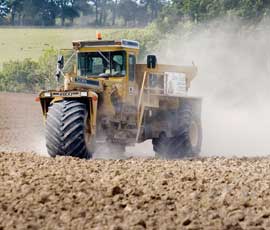Check soil for pH after this year’s deluge

Growers are being urged to carry out rigorous and systematic pH soil testing to assess the full effect of the torrential downpours across the country this summer.
The wet weather has also hampered the lime sector by affecting production. R and T Liming’s John Prentis is adamant that the situation is a practical one and can be salvaged. However, at the beginning of August he said that his company had only been able to produce about 1,000t of the 40,000t of lime they had available at the same time last year.
“To produce lime, either as chalk or as crushed quarried limestone, conditions have to be dry,” he says, “In East Anglia we make lime for agriculture by discing areas of chalk, then we scrape it up with motorway type machinery, and screen out the lumps. We need conditions similar or drier than those needed for making a seed-bed.
However, if farmers can harvest we can produce and spread lime. So as soon as it is fit we have the equipment and technology to make sure that lime is available wherever it is required.”
Mr Prentis says that all rain will leach lime out of the surface so acidity is most likely to be a problem where minimum tillage is practised. This is confirmed by agronomist Mike Osler who has been advising growers on the blow away sands in the Vale of York for 28 years.
“On these soils where the pH is naturally very low, it is best to plough first and then spread lime. If you spread the lime first then plough, you will be bringing low pH to the surface. For pH above 6.5, minimum tillage would be OK,” he says.
“On the sands, the break crop tends to be oilseed rape which is particularly susceptible to low pH, and shows poor growth with purpley-red colouring of the stalks. It should be grown at a minimum of pH7 whereas wheat can tolerate pH down to 6.3 before becoming poor and spindly.”
To grow rape on light soils Mr Osler, who works for Northwold Agronomy, says that the lime must go onto the surface, either before or after drilling. He stresses that no more than 5t/ha should be used at one time because of an adverse interaction with manganese availability. If chalk is used it neutralises quicker because it is finer, but coarser ground limestone has a longer lasting effect so either can be used.
Matt Ward, crop nutrition software manager at Farmacy in Dorrington Lincolnshire, also says that this season will be a particular problem for oilseed rape crops. This is because it is more sensitive to low pH than cereals – and late harvest means there will be a very narrow window of opportunity to rectify problems before optimum drilling time.
Mr Ward also highlights the very damaging effects of low pH on soil structure and drainage. At high pH the calcium ion exchange mechanism works within the soil so that particles flocculate together allowing good drainage. At low pH, soil particles slump and drainage is impeded. This is true for all soil types, but is particularly significant on very fine particled clay soils.
“There becomes a cycle of more waterlogging, leading to more leaching of negative ions and so more acidity which will inherently limit crop yields. A crop is only ever as good as its weakest point so you could throw all the nitrogen possible at it and it will never be any good until you do something about the drainage and pH,” he says.
Both agronomists and Mr Prentis say that pH testing is absolutely vital to quantify the effects of so much rain. Attempting to cut costs by not soil testing and liming this year would be a “recipe for disaster for the whole rotation”, according to Mr Ward.
Mr Prentis stresses that the variability of British soils in general means that taking one test sample on more than four hectares is not sufficient. Ideally, fields should be tested hectare by hectare and the results mapped so that lime can be applied specifically to rectify any problem areas. Sampling for pH on smaller areas unless there is a history of acidity, or applying quantities as low as 100kg/ha is not cost-effective, he believes.
Equally he says that applying more than 10t/ha is too much in one go. The damage to soil structure would out-weigh the value of liming so splitting the rate over several years should be considered.
Soil pH – key points
Rain leaches lime out of the surface
More of a problem with min till
Oilseed particularly susceptible to low pH

